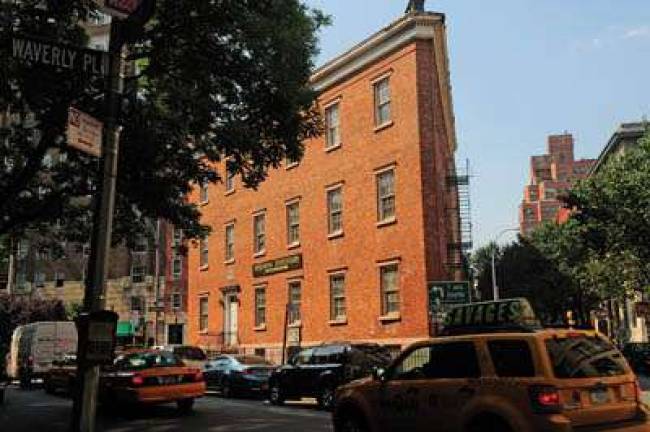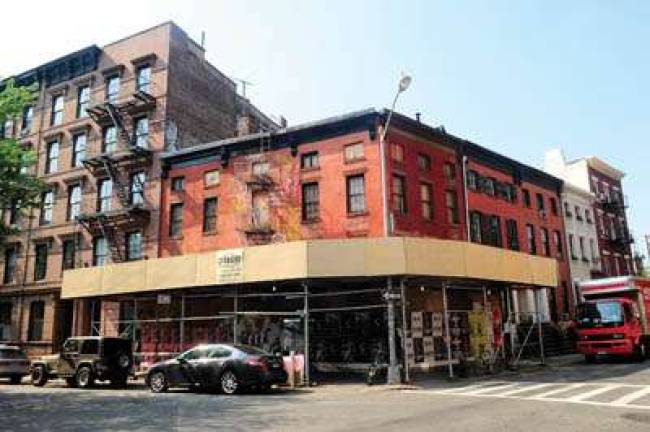It's difficult to imagine that amid the coveted, prime real estate of downtown Manhattan, where rates often top $200 per square foot for commercial space, some buildings remain idle, abandoned, deteriorating or otherwise neglected. Although it's unknown exactly how many abandoned, vacant or unused properties there are in the city, recent efforts to count such properties included a 2006 borough-wide survey of vacant properties undertaken by Manhattan Borough President Scott Stringer's office that identified enough undeveloped space in Manhattan alone to build more than 20,000 housing units. In 2011, the homeless advocacy organization Picture the Homeless did its own survey of abandoned buildings in the city and found more than 10,000 citywide, including more than 500 in Lower Manhattan. The stories behind some of these abandoned or neglected properties vary, according to housing experts, and run the gamut from financial difficulties for their owners to landlords who choose to speculate and intentionally keep buildings and apartments off the market in an effort to drive up prices. Still other reasons why properties are abandoned or neglected remain a mystery.
Northern Dispensary (165 Waverly Place) In the case of the landmarked Northern Dispensary, a former medical clinic built in 1831 in the West Village, the building has been vacant since 1998, when it was purchased by real estate investor William Gottlieb. "The building is a historical gem that has been lying vacant for decades," said Andrew Berman, president of the Greenwich Village Society for Historic Preservation (GVSHP). A notable bit of history of the building recalls that Edgar Allan Poe was once treated at the dispensary for a head cold in 1837, along with tens of thousands of needy patients. "The tragedy is that Gottlieb's estate continues to sit on it and not do anything with the building," Berman said. Gottlieb died in 1999. Calls to Neil Bender, Gottlieb's nephew and now sole controller of his 100 or so Village properties, were not returned. Simeon Bankoff, executive director of the Historic Districts Council, suggested his own idea for a use for the Dispensary. "I think it should be used once again as a medical clinic." Bankoff said that now more than ever, after the closing of St. Vincent's Hospital, the area is in need of another center to provide emergency or other medical care to village residents. A stipulation in the deed to the Dispensary requires the building's use to remain "serving the medical needs of the worthy poor." But it is unclear whether the stipulation is enforceable in the event that another use for the building is imminent. A proposal from the early 1990s to use the Dispensary as an AIDS hospice never came to fruition. Berman added that he still gets regular calls from people asking why the building is empty, suggesting appropriate uses. Berman said that a couple of years ago, an architect checked the building to make sure it wasn't deteriorating and it appeared to be in decent shape. "The best way to preserve a building is to use it," he said. "We hope the building will be brought back to life sometime soon." 43 MacDougal Street While the Northern Dispensary may be unused, at least its condition appears satisfactory. Such is not the case with 43 MacDougal St., an 1846 row house located in the Charlton-King-Vandam Historic District. Berman and the GVSHP have documented conditions at the long-vacant building that include rats, mice, water damage and deteriorating materials, which have contributed to the building's structural instability. According to both Berman and the Landmarks Preservation Commission (LPC), the building's previous owners, the estate of Arthur Blasof, were unresponsive, despite racking up nearly $120,000 in building violations. In fact, the situation was bad enough that in 2009, the LPC sent a letter to the owner of the building regarding initiation of a demolition by neglect lawsuit, which would compel the owner to make necessary repairs to the house. Berman's group also reported that graffiti was present on the building's façade and that squatters have been seen in the building and on the sidewalk shed at different times over the last few years, a "great safety concern to neighbors." In September of last year, Para Mac Holding of Brooklyn bought 43 MacDougal St. for about $449,000 and Berman sent a letter on behalf of the GVSHP to the new owner advising him that funding for restorative work is available, since the building is located in a historic district. "Some preliminary steps have been taken to stabilize the building, such as shoring the roof and boarding windows, but there is still a long way to go?to bring this building back from the brink of deterioration," said Berman. (http://nypress.com/wp-content/uploads/2012/06/JoeWolf_CityHallStation_o.jpg) Old City Hall Subway Station (Park Row & City Hall Park) Adventurous subway riders who have remained aboard the 6 train as it leaves the Brooklyn Bridge station and loops back around to head north may have noticed an unusually ornate, well-maintained station that no one has used since 1945. That station is the all-but-abandoned old City Hall station, which opened in 1904 and still sits on a loop of track in front of City Hall. It was the original southern terminal of the Interborough Rapid Transit subway. According to the New York Transit Museum, the station's platform and mezzanine feature Guastavino arches and skylights, colored glass tilework and brass chandeliers. The arched ceiling of the platform area includes brass light fixtures along its length. The undoing of the City Hall station was an expansion of the subway system and subsequent station lengthening in the 1940s and 1950s. City Hall, because it was situated on a tight curve, could not be lengthened. That, combined with new longer trains with center doors on each car, made it dangerous to open the train's doors due to a large gap that formed between the doors and the platform. The MTA decided to abandon the station in favor of the nearby Brooklyn Bridge station. City Hall closed to passenger service on Dec. 31, 1945. According to NYCsubways.org, the City Hall station was never particularly well-used, as the nearby Brooklyn Bridge station served both local and express trains and had the Brooklyn Bridge streetcar terminal above it. The Transit Museum hosts periodic tours of the station; the last one for this season was June 17. Plans to reopen the station have never come to fruition due to perceived security risks in the area around City Hall. (http://nypress.com/wp-content/uploads/2012/06/JonathanSpringer_TAB3310-150barrow.jpg) Keller Hotel (150 Barrow Street) The Gottlieb estate is the owner of yet another abandoned, historic property: The Keller Hotel. The building is one of the last surviving Hudson River waterfront hotels that served transient sailors around the turn of the century, according to records from the LPC. It was built in 1897 in the Renaissance revival style by German designer Julius Munckwitz, then the supervising architect and superintendent of parks for New York City. LPC documents indicate that during the 1980s, the Keller Hotel became a single room occupancy hotel that the city used to house the indigent. Berman noted that, in the case of the Keller Hotel, the Gottlieb estate supported the landmarking of the building in 2006 and had quite a bit of work done in an effort to convert the upper floors into residential apartments. "They started doing the work and then they just stopped several years ago?it's a mystery, and it's particularly striking, with the location of the building-Manhattan's 'Gold Coast' on the Greenwich Village waterfront," Berman said. He went on to say that "whatever is holding up" the construction of the apartments has less to do with market interest in the site and more to do with the "Gottliebs and the way they do or don't get things done." A check of Department of Buildings records confirmed that no work is currently being performed on the Keller Hotel. Berman worries that the building's "lack of work and lack of attention" may allow further deterioration if work is not resumed in the near future.



